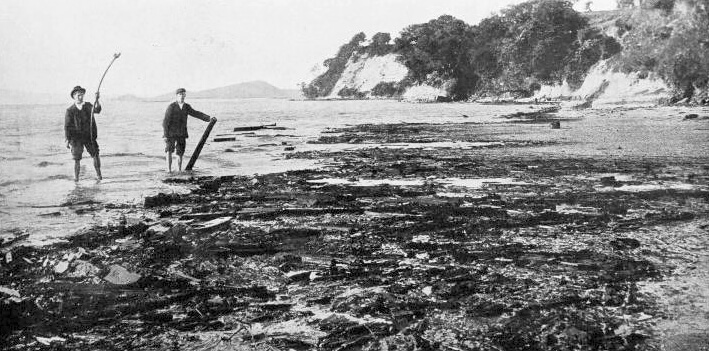There was no hope for John and Elizabeth Finch of Paterangi in an Auckland explosion, or was there? Meghan Hawkes recounts the story.

The Tamaki foreshore after the explosion of he powder hulk Cloud.
Masses of flames and smoke shooting upwards for hundreds of metres over Auckland made a cloud-effect reminiscent of the Tarawera eruption on a November afternoon in 1909.
A colossal explosion was heard all around the city and suburbs, causing broken windows for a great distance, both around the harbour frontage and inland.
Mr Wright, artist, standing on the roof of the Victoria Arcade saw a column of smoke blast up in the direction of Tamaki followed by a dull and distant report. Mr Alder, on the top of the rise at St Heliers Bay, heard the noise, felt the shock and saw the explosion quite plainly.
He thought it must be the powder hulk, the Cloud, in which Auckland’s reserve supply of explosives was kept out of harm’s way in the harbour, blowing up. Nothing else could have caused such an explosion. He was right.
George Taylor, signalman at Mt Victoria station, telephoned the Harbour Board reporting that there had been a big explosion in the direction of where the hulk was lying, and that after the smoke had cleared away he could not see the vessel.
The powder hulk was occupied by a caretaker, John Finch, from Paterangi, appointed to the position only 10 days previously, and his wife, Elizabeth.
There was no hope of their survival. Newspaper headlines were immediately written – Terrific Explosion – Complete Disappearance – Concussion felt in the city – Loss of life feared.
The Cloud had been dismantled and converted into a powder hulk for the Auckland Harbour Board seven years previously, being used by agents for explosives importers and manufacturers. It had about 20 tons of explosives aboard at the time of the explosion, which was less than the usual amount, only two firms having stocks stored in the hulk. The stocks consisted of blasting powder, in loose and pellet form, and about two tons of gelignite.
The police searched the coast, and dragged the water for the couple’s bodies, an ominously empty boat having drifted ashore. The Harbour Board tug, a launch, and one or two other vessels put out from Auckland to search as well.
At 2.50pm the Auckland Star was advised by telephone that a small boat and some people were to be seen on the shore at Tamaki. Astonishingly, they were discovered to be the Finches who had made a miraculous escape from death.
Their day had begun with John extinguishing the ship’s lights at daybreak, then washing the decks down. He noticed a smell of burning and went to the galley to ask Elizabeth about it. She had lit the fire and was starting breakfast. A little later John went through the living quarters and around the hulk but could not see anything amiss. Thinking the smell must be from something burning in the galley he returned to his work but after a few minutes saw smoke coming from the fore-scuttle.
John went down the fore-scuttle, where he saw nothing but smoke, eventually locating the fire in the stern of the vessel. Coming back up and going aft he noticed a red glare through an aperture in the scroll. He cut through the decking with an axe to find the location of the fire and was faced with a great glowing mass – the whole interior was on fire.
Realising the fearful position they were in, isolated on a burning powder hulk, with no means of attracting attention, John got Elizabeth to bring buckets of water from the two tanks on deck. He threw the water on the flames, at the same time drawing up further buckets of water from over the side, and also dashed those below. Their frenzied efforts to fight the flames went on for hours until the water in the tanks gave out. Elizabeth was exhausted and John placed her in a boat, lowered it, and cast it adrift.
He then made two attempts to scuttle the hulk forward, but was nearly suffocated on both occasions, the second time collapsing on the deck. On recovering he found flames bursting through the decks and afterpart of the vessel. He realised there was no more hope of saving anything and he dived overboard and swam to his wife. He was so utterly exhausted Elizabeth had to haul him into the boat. After a while the pair rowed for the shore, landing safely at Tamaki, and from there were taken to town in a sailing craft. Both were in a pitiable plight after their terrifying experience.
John Finch had been a seaman for eight years and had experience in mines. His conduct on the burning hulk saw him referred to in print as ‘A hero of peace.’ ‘The brave caretaker’ and ‘his plucky wife’ had set an example of devotion to duty which all New Zealanders should be proud of.
However, other news reports bordered on sarcasm – “Anybody who will deliberately remain for hours in a burning powder hulk is either a hero or something else. However, ’tis a certainty that nobody can contradict Finch’s yarn, even if he desired to do so.”
There were also insensitive comparisons to Casablanca – a bombardment with explosives by the French Navy in 1907 which destroyed the Moroccan city and caused hundreds of deaths. Newspapers also sniped at each other‘s reporting, one mocking the “columns of penny dreadful reading, surmounted by thrilling and awe-inspiring double-column headlines.”
Against this background John and Elizabeth Finch all but disappeared, probably relocating, possibly changing identities – a dismal consequence for the couple who appeared to have been resurrected.
- A court case the following year pointed to sparks from the galley finding their way into the hold, starting the fire. John Finch was cleared of blame and the Auckland Harbour Board sued the explosives owners.








